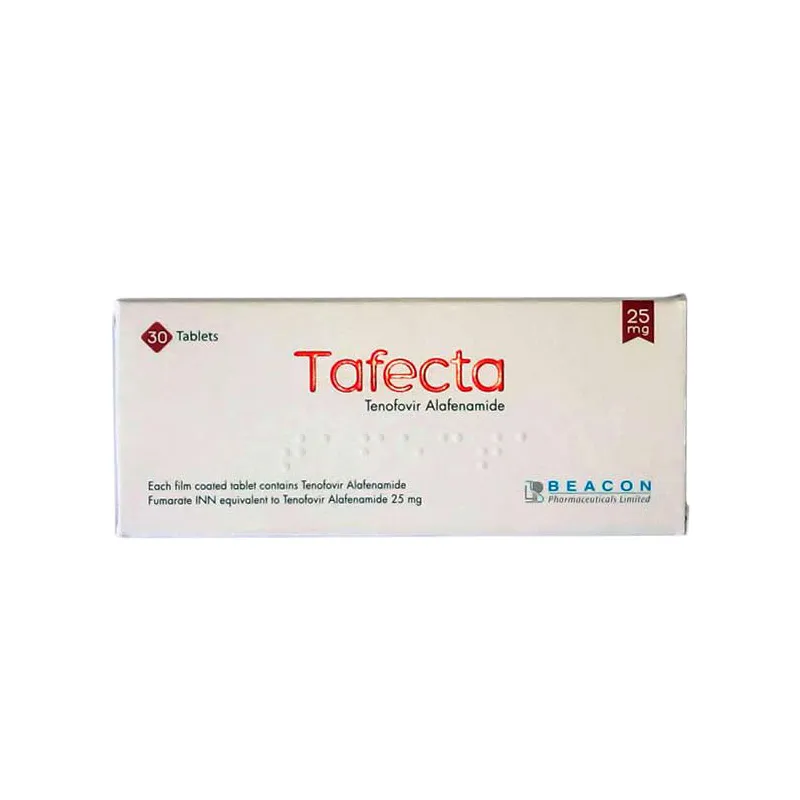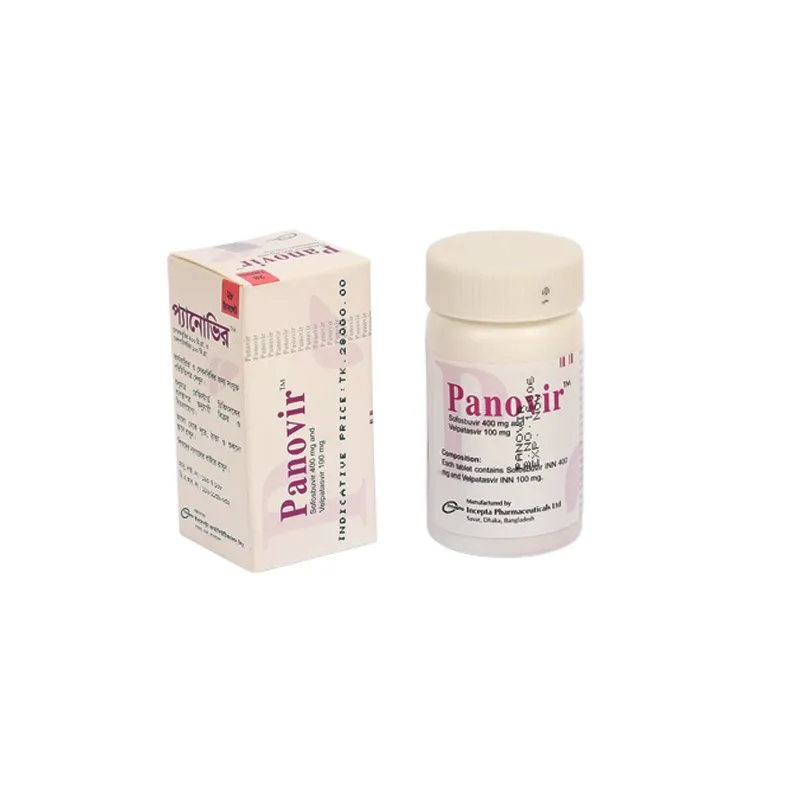Buy Tafecta 25 Mg (Tenofovir)
Inquire UsDescription
What is Tafecta 25 MG (Tenofovir)?
Tafecta (Tenofovir) is used along with other medications to treat human immunodeficiency virus (HIV) infection in adults and children 2 years of age and older. Tenofovir is also used to treat chronic (long term) HBV in adults and children 2 years of age and older weighing 22 pounds (10 kilograms) or more. Tenofovir is in a class of medications called nucleoside reverse transcriptase inhibitors (NRTIs). It works by decreasing the amount of HIV and HBV in the blood. Although tenofovir will not cure HIV, it may decrease your chance of developing acquired immunodeficiency syndrome (AIDS) and HIV-related illnesses such as serious infections or cancer.
Taking these medications along with practicing safer sex and making other lifestyle changes may decrease the risk of transmitting the HIV virus to other people. Tenofovir will not cure hepatitis B and may not prevent complications of chronic hepatitis B such as cirrhosis of the liver or liver cancer. Tenofovir may not prevent the spread of hepatitis B to other people. To know more about tenofovir visit here.
Why should you buy the generic Tafecta 25 mg online?
First of all generic Tafecta is very affordable version of Tenofovir for hepatitis B patients. It is a verified generic version of Viread. Beacon pharmaceuticals Limited manufacture this generic version in Bangladesh. It is one of the renowned pharmaceutical companies who mostly made cancer medicine in Bangladesh. After the Directorate General of Drug Administration of Bangladesh approves to manufacture tenofovir alafenamide, they started to make it and sell it all over the world where generic medicine is allowed to use. It is the first generic version of Viread which is selling regularly all over the world. It is also 90% cheaper than the brand version Which cost you less than 50 dollars. Other popular hepatitis medicine are panovir, velpanex.
COMPOSITION
Tafecta Tablet: Each film coated tablet contains Tenofovir Alafenamide Fumarate (TAF) INN equivalent to Tenofovir Alafenamide 25 mg.
CLINICAL PHARMACOLOGY OF TAFECTA 25 MG
Mechanism Of Action
Tenofovir Alafenamide is a phosphonamidate prodrug of Tenofovir (2′-deoxyadenosine monophosphate analog). Tenofovir Alafenamide as a lipophilic cell-permeant compound enters primary hepatocytes by passive diffusion and by the hepatic uptake transporters OATP1 B1 and OATP1 B3. Tenofovir Alafenamide is then converted to Tenofovir through hydrolysis primarily by carboxylesterase 1 (CES1) in primary hepatocytes. Intracellular Tenofovir is subsequently phosphorylated by cellular kinases to the pharmacologically active metabolite Tenofovir Diphosphate.
Tenofovir Diphosphate inhibits Hepatitis B Virus (HBV) replication through incorporation into viral DNA by the HBV reverse transcriptase, which results in DNA chain-termination.
Tenofovir Diphosphate is a weak inhibitor of mammalian DNA polymerases that include mitochondrial DNA polymerase y and there is no evidence of toxicity to mitochondria in cell culture.
Pharmacodynamics
Cardiac Electrophysiology
In a thorough QT/QTc study in 48 healthy subjects, Tenofovir Alafenamide at the recommended dose or at a dose 5 times the recommended dose did not affect the QT/QTc interval and did not prolong the PR interval.
Specific Populations
Geriatric Patients, Race and Gender
No clinically relevant differences in Tenofovir Alafenamide or Tenofovir pharmacokinetics due to race or gender have been identified.
Patients with Renal Impairment
Relative to subjects with normal renal function (estimated creatinine clearance >90 mL/min), the Tenofovir Alafenamide and Tenofovir systemic exposures in subjects with severe renal impairment were 1.9-fold and 5.7-fold higher, respectively. The pharmacokinetics of Tenofovir Alafenamide have not been evaluated in patients with creatinine clearance less than 15 mL per minute.
Patients with Hepatic Impairment
Relative to subjects with normal hepatic function, Tenofovir Alafenamide and Tenofovir systemic exposures were 7.5% and 1 1 % lower in subjects with mild hepatic impairment, respectively.
HIV and/or Hepatitis C Virus Coinfection
The pharmacokinetics of Tenofovir Alafenamide have not been fully evaluated in subjects coinfected with HIV and/or hepatitis C virus.
INDICATION
Tenofovir Alafenamide is indicated for the treatment of chronic hepatitis B virus (HBV) infection in adults with compensated liver disease.
DOSAGE AND ADMINISTRATION
Testing Prior to Initiation of Tenofovir Alafenamide
Prior to initiation of Tenofovir Alafenamide, patients should be tested for HIV-1 infection. Tenofovir Alafenamide alone should not be used in patients with HIV infection. It is recommended that serum creatinine, serum phosphorous, estimated creatinine clearance, urine glucose and urine protein be assessed before initiating Tenofovir Alafenamide and during therapy in all patients as clinically appropriate.
Recommended Dosage in Adults
The recommended dosage of Tenofovir Alafenamide is 25 mg (one tablet) taken orally once daily with food.
Dosage in Patients with Renal Impairment
No dosage adjustment of Tenofovir Alafenamide is required in patients with mild, moderate, or severe renal impairment. Tenofovir Alafenamide is not recommended in patients with end stage renal disease (estimated creatinine clearance below 15 mL per minute).
Dosage in Patients with Hepatic Impairment
No dosage adjustment of Tenofovir Alafenamide is required in patients with mild hepatic impairment (Child-Pugh A). Tenofovir Alafenamide is not recommended in patients with decompensated (Child-Pugh B or C) hepatic impairment.
USE IN SPECIFIC POPULATION
Pregnancy
There are no human data on the use of Tenofovir Alafenamide in pregnant women to inform a drug-associated risks of adverse fetal developmental outcome. In animal studies, no adverse developmental effects were observed when Tenofovir Alafenamide was administered during the period of organogenesis at exposure equal to or 51 times (rats and rabbits, respectively) the Tenofovir Alafenamide exposure at the recommended daily dose of Tenofovir Alafenamide. No adverse effects were observed in the offspring when TDF (Tenofovir Disoproxil Fumarate) was administered through lactation at Tenofovir exposures of approximately 12 times the exposure at the recommended daily dosage of Tenofovir Alafenamide.
Lactation
It is not known whether Tenofovir Alafenamide and its metabolites are present in human breast milk, affect human milk production or have effects on the breastfed infant. Tenofovir has been shown to be present in the milk of lactating rats and rhesus monkeys after administration of Tenofovir Disoproxil Fumarate. It is not known if Tenofovir Alafenamide can be present in animal milk. The developmental and health benefits of breastfeeding should be considered along with the mother’s clinical need for Tenofovir Alafenamide and any potential adverse effects on the breastfed infant from Tenofovir Alafenamide or from the underlying maternal condition.
Pediatric use
Safety and effectiveness of Tenofovir Alafenamide in pediatric patients less than 18 years of age have not been established.
Geriatric Use
Clinical trials of Tenofovir Alafenamide did not include sufficient numbers of subjects aged 65 years and over to determine whether they respond differently from younger subjects.
Renal Impairment
No dosage adjustment of Tenofovir Alafenamide is required in patients with mild, moderate, or severe renal impairment. Tenofovir Alafenamide is not recommended in patients with end stage renal disease .
Hepatic Impairment
No dosage adjustment of Tenofovir Alafenamide is required in patients with mild hepatic impairment (Child-Pugh A). The safety and efficacy of Tenofovir Alafenamide in patients with decompensated cirrhosis (Child-Pugh B or C) have not been established; therefore Tenofovir Alafenamide is not recommended in patients with decompensated (Child-Pugh B or C) hepatic impairment.
CONTRAINDICATION
None
WARNINGS AND PRECAUTION
Lactic Acidosis/Severe Hepatomegaly with Steatosis
Lactic acidosis and severe hepatomegaly with steatosis, including fatal cases, have been reported with the use of nucleoside analogs, including Tenofovir Disoproxil Fumarate in combination with other antiretrovirals. A majority of these cases have been in women. Obesity and prolonged nucleoside exposure may be risk factors. Particular caution should be exercised when administering nucleoside analogs to any patient with known risk factors for liver disease; however, cases have also been reported in patients with no known risk factors. Treatment with Tenofovir Alafenamide should be suspended in any patient who develops clinical or laboratory findings suggestive of lactic acidosis or pronounced hepatotoxicity (which may include hepatomegaly and steatosis even in the absence of marked transaminase elevations).
Severe Acute Exacerbation of Hepatitis B after Discontinuation of Treatment
Discontinuation of anti-hepatitis B therapy, including Tenofovir Alafenamide, may result in severe acute exacerbations of hepatitis B. Patients who discontinue Tenofovir Alafenamide should be closely monitored with both clinical and laboratory follow-up for at least several months after stopping treatment. If appropriate, resumption of anti-hepatitis B therapy may be warranted.
Risk of Development of HIV-I Resistance in Patients Coinfected with HBV and HIV-1
Due to the risk of development of HIV-1 resistance, Tenofovir Alafenamide alone is not recommended for the treatment of HIV-1 infection. The safety and efficacy of Tenofovir Alafenamide have not been established in patients coinfected with HBV and HIV-1. HIV antibody testing should be offered to all HBV-infected patients before initiating therapy with Tenofovir Alafenamide, and, if positive, an appropriate antiretroviral combination regimen that is recommended for patients coinfected with HIV-1 should be used.
New Onset or Worsening Renal Impairment
Renal impairment, including cases of acute renal failure and Fanconi syndrome (renal tubular injury with severe hypophosphatemia), has been reported with the use of Tenofovir prodrugs in both animal toxicology studies and human trials. In clinical trials of Tenofovir Alafenamide, there have been no cases of Fanconi syndrome or Proximal Renal Tubulopathy (PRT).
Patients taking Tenofovir prodrugs who have impaired renal function and those taking nephrotoxic agents, including non-steroidal anti-inflammatory drugs, are at increased risk of developing renal-related adverse reactions.
It is recommended that serum creatinine, serum phosphorous, estimated creatinine clearance, urine glucose and urine protein be assessed before initiating Tenofovir Alafenamide and during therapy in all patients as clinically appropriate. Discontinue Tenofovir Alafenamide in patients who develop clinically significant decreases in renal function or evidence of Fanconi syndrome.
ADVERSE REACTIONS
Most common adverse reactions are headache, abdominal pain, fatigue, cough, nausea and back pain.
DRUG INTERACTION
Potential for Other Drugs to Affect Tenofovir Alafenamide
Tenofovir Alafenamide is a substrate of P-glycoprotein (P-gp) and BCRP. Drugs that strongly affect P-gp and BCRP activity may lead to changes in Tenofovir Alafenamide absorption. Drugs that induce P-gp activity are expected to decrease the absorption of Tenofovir Alafenamide, resulting in decreased plasma concentrations of Tenofovir Alafenamide, which may lead to loss of therapeutic effect of Tenofovir Alafenamide. Co-administration of Tenofovir Alafenamide with other drugs that inhibit P-gp and BCRP may increase the absorption and plasma concentration of Tenofovir Alafenamide.
Drugs Affecting Renal Function
Because Tenofovir is primarily excreted by the kidneys by a combination of glomerular filtration and active tubular secretion, coadministration of Tenofovir Alafenamide with drugs that reduce renal function or compete for active tubular secretion may increase concentrations of Tenofovir and other renally eliminated drugs and this may increase the risk of adverse reactions.
Some examples of drugs that are eliminated by active tubular secretion include, but are not limited to, Acyclovir, Cidofovir, Ganciclovir, Valacyclovir, Valganciclovir, Aminoglycosides (e.g., Gentamicin), and high-dose or multiple NSAIDs.
PHARMACEUTICAL INFORMATION
Storage Conditions
Store in a cool and dry place, away from light. Keep out of the reach of children.
Presentation & Packaging
Tafecta Tablet: Each commercial box contains 30 tablets in Alu-Alu blister pack.
Buy Tafecta 25 Mg Online
Are you interested to buy tafecta 25 mg online? Don’t worry. 100 Meds can help you to find reliable and verified medicine at affordable cost. Please contact our support team by using email, whatsapp or wechat. Even you can contact our facebook page.
You must be logged in to post a review.



Reviews
There are no reviews yet.